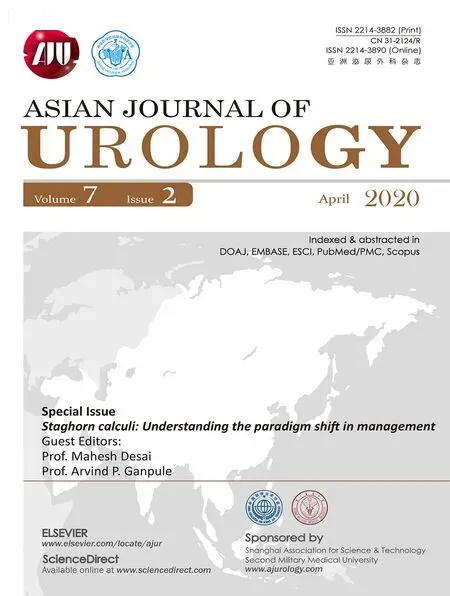Staghorn calculi: Understanding the paradigm shift in management
Staghorn calculi are globally prevalent, irrespective of geography, gender, age and life style. If not detected early they can damage renal function and may lead to kidney failure. Staghorn stones may lead to deterioration of renal function and life threatening sepsis. This is the reason why this clinical entity should be managed aggressively.The last 3 decades has seen a paradigm shift in the management of staghorn calculi from open surgery, large tract standard PCNL, and now further smaller tracts. This issue of Asian Journal of Urology deals with all aspects of staghorn calculi management including preoperative planning, role of multitract percutaneous nephrlithotomy (PCNL), flexible ureteroscopy and metabolic aspects of staghorn calculi.
Since long, it is known that proper planning is key to success, be it open surgery or endourology. The corner stone to planning in such stones is appropriate use of imaging modalities to understand the distribution of these stones in the pelvicalyceal system. The clinical utility of staghorn morphometry is well proven and is based on the understanding that the success rates and clearance of stones depend on the anatomic configuration of pelvicalyceal system and the stone.
The epidemiology of stones is ever changing. The incidence of staghorn stones is steadily decreasing. A few decades ago the underdeveloped countries reported patients having large bladder stones and staghorn calculi,and slowly the incidence of these stones has shown a decline.Mirroring this trend in epidemiology there is also a shift from multitract large tract PCNL to further minimally invasive options such as multitract “minipercs” and flexible ureteroscopies. As it is famously said “once a stone former always a stone former”, the metabolic aspect of stone formation is one thing which cannot be neglected. The articles in this issue have highlighted this fact.
This issue of Asian Journal of Urology addresses all the topics of staghorn stone management including morphometry, role of multitract PCNL, trouble shooting in staghorn calculi, metabolic evaluation of staghorn stones and last but not the least management of this disease entity in special situations.
We have been fortunate to have contributors who require no introduction and are stalwarts in the endourologic surgery arena.The authors of this edition come across the globe from Turkey, China, Switzerland, Germany,United States and India. We are sure that this issue would make a informative reading for all.
 Asian Journal of Urology2020年2期
Asian Journal of Urology2020年2期
- Asian Journal of Urology的其它文章
- Robot-assisted laparoscopic prostatectomy:How can we get better?
- Management of staghorn stones in special situations
- Preoperative imaging in staghorn calculi,planning and decision making in management of staghorn calculi
- Carcinoma bladder and sliding bladder hernia: Unusual association of paramount significance
- Total pelvic exenteration and a new model of diversion for giant primitive neuroectodermal tumor of prostate: A case report and review of the literature
- A prospective study of patient reported urinary incontinence among American,Norwegian and Spanish men 1 year after prostatectomy
